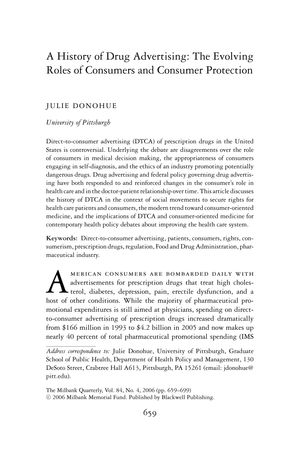A History of Drug Advertising: The Evolving Roles of Consumers and Consumer Protection
November 2006
in “
The Milbank Quarterly
”

TLDR Drug advertising has greatly increased, changing consumer behavior and raising concerns about its influence on healthcare and patient protection.
The document from 2006 examines the history of direct-to-consumer advertising (DTCA) of prescription drugs in the United States, detailing the increase in DTCA spending from $166 million in 1993 to $4.2 billion in 2005 and its implications for consumer protection and the doctor-patient relationship. It traces the evolution from early 20th-century self-medication to physician-prescribed treatments, the impact of various legislative acts on drug advertising, and the rise of consumer-oriented medicine. The document also discusses the FDA's regulatory approach to DTCA, including the 1969 requirement for a fair balance in advertisements, the 1970s patient package inserts, and the 1985 rescinding of a moratorium on DTCA. It notes the initial opposition to DTCA from physicians, consumer groups, and pharmaceutical companies, but describes how changes in the healthcare system and consumer attitudes led to the pharmaceutical industry embracing DTCA, particularly for lifestyle drugs like Rogaine. The document also covers the FDA's shift in the 1990s towards more lenient DTCA regulations, the mixed reactions from the AMA, physicians, and consumer groups, and the influence of DTCA on consumer behavior. Finally, it addresses the broader cultural shift towards consumerism in healthcare, the ethical concerns about the pharmaceutical industry's influence, and the potential impact of DTCA on future patient and consumer protection efforts, contrasting the U.S. approach with the rejection of DTCA in European countries.
